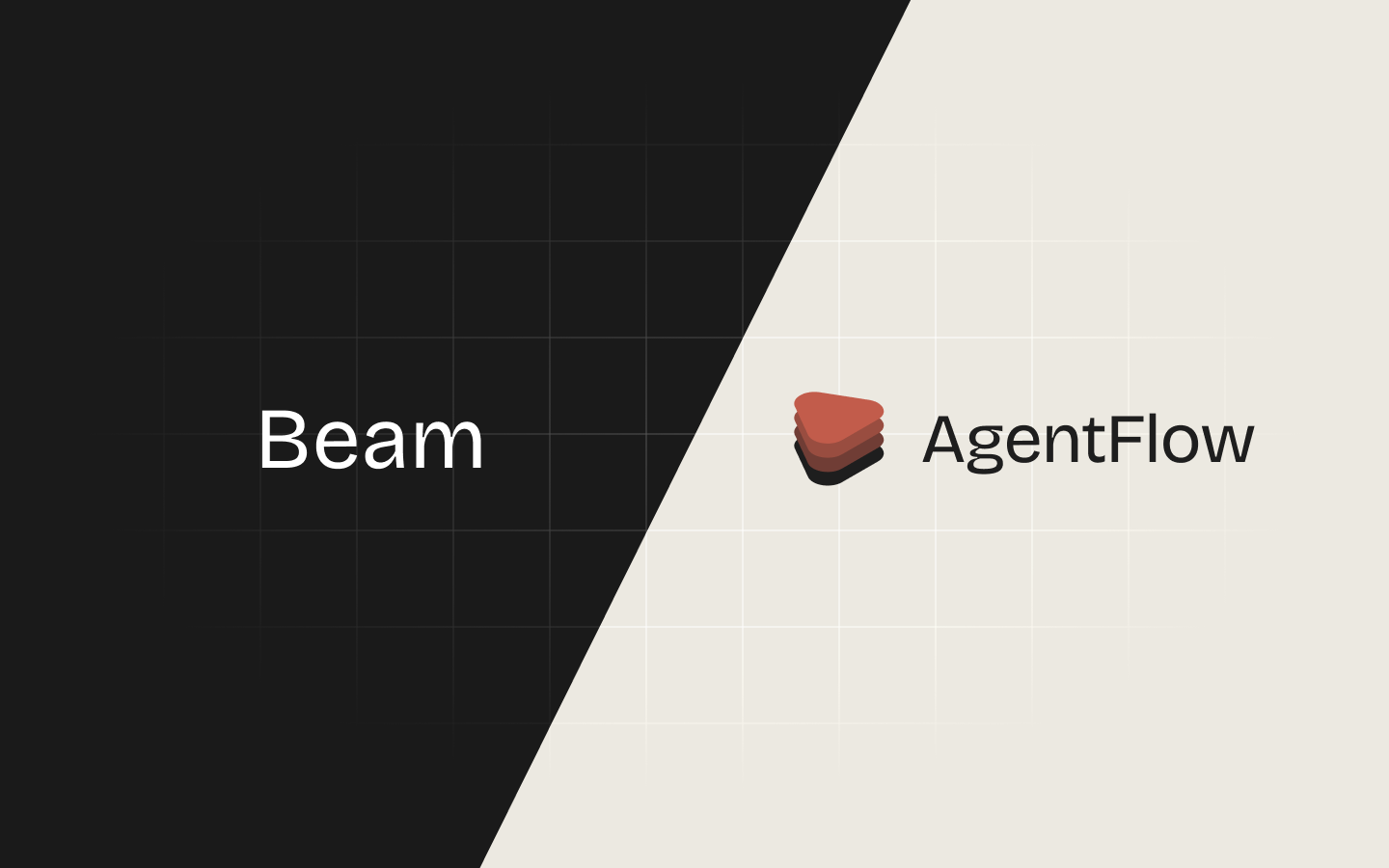AgentFlow vs. Beam:
Agentic AI Platform Comparison
With deep domain expertise, superior governance, and faster deployment timelines, AgentFlow is purpose-built for financial services and insurance institutions. While Beam offers a more horizontal platform, AgentFlow provides the security, explainability, and workflow alignment that regulated enterprises demand.

Why Companies Are Choosing AgentFlow
Vertical specialization
AgentFlow is tailored specifically for finance and insurance, providing agents pre-configured for loan origination, underwriting, claims processing, and compliance. Beam’s broad approach lacks the same depth, often requiring costly customization.
.png)
Faster deployment
AgentFlow can be configured and deployed in 90 days or less, supported by our forward-deployed engineers. Beam implementations often require extensive integration cycles, stretching deployment timelines.
.png)
Stronger governance
Every decision in AgentFlow is logged with confidence scores, audit trails, and regulatory alignment (IFRS 9, CECL, Basel III). Beam lacks equivalent out-of-the-box governance, creating risks for regulated enterprises.
.png)
SME-driven adaptability
AgentFlow empowers business operators (underwriters, claims adjusters, loan officers) to adjust workflows without engineering. Beam’s horizontal design places more reliance on technical teams, slowing adaptation.
.png)
AgentFlow vs. Beam
Feature
AgentFlow
Beam
Expertise
Purpose-built for finance & insurance
Broad, horizontal focus
Governance
Confidence scores, audit trails, compliance alignment
Limited governance out-of-the-box
Deployment Speed
Deploy in <90 days
Longer integration cycles
Security
SOC 2 Type II, VPC/on-prem, full data control
Shared SaaS environment
Adaptability
SME-driven configuration, continuous feedback loops
Requires engineering customization
Transparency
Explainable AI, regulator-grade reporting
Black-box outputs in some workflows
AgentFlow vs. Beam: Deeper Analysis
.svg)
Expertise
AgentFlow was built specifically for these sectors, with pre-configured workflows covering mission-critical functions such as claims adjudication, underwriting, loan processing, and compliance reviews. These workflows are fine-tuned to handle complex data formats, regulatory checks, and edge cases that generic systems struggle with. By productizing decades of financial and insurance knowledge, AgentFlow reduces the risk of errors and accelerates adoption, since teams can begin using industry-aligned agents from day one.
Beam, on the other hand, follows a horizontal approach. Its platform is designed to support multiple industries, which gives it flexibility but dilutes its ability to address industry-specific needs. For financial services firms, this means Beam often requires significant customization before it can be production-ready. Building financial workflows from scratch on a horizontal platform can lead to longer implementation cycles, higher professional services costs, and the possibility of compliance gaps if the system does not fully align with industry requirements. While Beam can operate in financial contexts, it does not come pre-equipped with the specialized logic that institutions in these markets demand.
.svg)
Governance
AgentFlow embeds governance features as a first-class priority. Every decision is logged with audit trails, confidence thresholds ensure appropriate human oversight, and role-based access controls protect sensitive information.
Beyond this, the platform includes model versioning and retraining cycles aligned with regulatory frameworks like IFRS 9, CECL, and Basel III. These safeguards ensure that AI decisions are transparent, defensible, and aligned with internal and external compliance standards.
Beam offers governance features but not with the same rigor. Its capabilities are more generic, designed for multi-industry deployment, which means financial services organizations are often left to build out governance controls themselves. This creates additional cost and slows adoption, while also increasing operational risk. Without regulator-grade governance built in, Beam requires customers to layer in external tools and processes to meet compliance needs. AgentFlow’s governance-first design eliminates that overhead, making it safer and faster to deploy in regulated settings.
.svg)
Deployment
AgentFlow offers private deployments in under 90 days, made possible by its buy-to-build model and Multimodal’s Forward Deployed Engineers. These engineers embed directly with client teams including underwriters, claims managers, loan officers, to co-build production-ready workflows. This approach ensures that the AI system reflects how business is actually done, reducing friction and accelerating adoption.
Beam’s deployments typically extend much longer. Because the platform is designed for broad use, financial and insurance customers must invest significant time in configuring workflows, testing compliance readiness, and ensuring alignment with their unique processes.
This extra effort delays time-to-value and can create frustration among stakeholders who expect faster results. AgentFlow’s structured deployment process, combined with its industry-ready templates, enables organizations to see measurable ROI in months rather than years.

Security
Beam’s security posture, while strong, relies primarily on a SaaS-first model. This approach can simplify deployment for general industries, but it creates barriers for financial institutions where data sovereignty and private infrastructure are mandatory. Shared infrastructure and limited deployment flexibility can become major blockers during procurement, delaying or preventing adoption altogether. AgentFlow’s private, security-first model is a better fit for regulated enterprises where trust in data handling is paramount.
.svg)
Adaptability
AgentFlow was built for SME-driven adaptability. Business users, claims managers, underwriters, loan officers, can configure workflows directly, monitor agent behavior, and refine outputs without waiting on engineering support. The platform includes intuitive dashboards, drag-and-drop document handling, and embedded feedback loops that ensure agents continuously improve over time. This hands-on adaptability accelerates trust, since SMEs retain control of how decisions are made and audited.
Beam’s adaptability relies more heavily on technical teams. While business users can interact with the system, changes to workflows often require engineering intervention. This slows down responsiveness to regulatory or policy shifts, increases costs, and creates bottlenecks in adoption. For industries where agility is essential, Beam’s engineering-heavy approach can be a disadvantage. AgentFlow, by contrast, empowers SMEs to drive automation directly, reducing dependency on IT and making the system more aligned with business needs.
.svg)
Transparency
AgentFlow ensures every AI action is transparent, traceable, and defensible to regulators. Confidence scores are tied to each decision, and audit logs record the full context of how an output was generated. This regulator-grade transparency allows compliance teams to review and validate decisions, ensuring institutions stay aligned with audit and risk management standards. For business users, explainable AI increases confidence in adoption, since they can understand not only what decision was made, but also why.
Beam includes explainability features, but they are not designed with the same level of rigor required by regulated industries. Outputs can feel more “black box,” which may be acceptable in less-regulated sectors but poses challenges in finance and insurance. Without regulator-ready transparency, Beam’s adoption in these markets may be limited or require additional tooling to close the gap. AgentFlow’s transparency ensures that AI decisions can withstand regulatory scrutiny, building trust with both auditors and frontline employees.

“Over the period of such a short time, Multimodal delivered something that is traditionally impossible for a software company of any scale. Plus, they have the know-how needed to build AI that outperforms even major industry players. That's why we intend to keep building together.”

FAQ
Yes, for finance and insurance organizations. While Beam offers horizontal AI capabilities, AgentFlow is purpose-built for regulated industries, delivering faster deployment, stronger governance, and domain-specific expertise.
Yes. AgentFlow offers VPC and on-prem options, ensuring full data control. Beam primarily relies on shared SaaS models.
AgentFlow deployments typically go live in 90 days or less, compared to Beam’s longer integration cycles.
Business operators (SMEs) can directly configure and monitor agents, reducing reliance on engineering teams.
Yes. AgentFlow is API-first and designed to integrate seamlessly with existing workbenches, databases, and compliance systems.
.svg)
.svg)
.svg)
.svg)